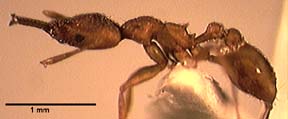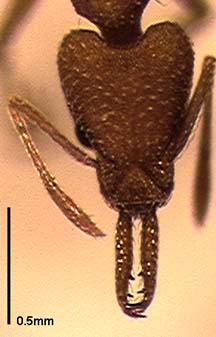
Specimen: Costa Rica, Prov. Heredia: La Selva Biological Station (FPM/08/28). INBIOCRI001229706. Image by J. Longino.
Identification
Apical fork of mandible with two intercalary teeth; mandible with two pronounced preapical teeth; eye large, with over 35 facets; dorsal and ventral teeth of propodeal lamella pronounced, acute; gaster smooth with basal costulae; gaster covered with closely appressed, spatulate setae.
Head length 0.80-0.85mm, mandible length 0.44-0.47, CI 75, MI 55 (n=8 workers from 1 locality in Brazil; Brown 1962).
Similar species: fairchildi.
Range
Brazil, Costa Rica (Atlantic slope).
Natural History
Brown and Wilson (1959) summarize the genus as follows:
"Widespread in tropics and warm temperate areas. Primarily forest-dwelling; some species occur in grassland and arid scrub. ... Nests mostly in soil and rotting wood; a few species live in arboreal plant cavities in tropical rain forest. Foraging hypogaeic to epigaeic-arboreal. Food: most species are collembolan feeders; a few are polyphagous predators or occasionally feed on sugary substances..."
Bequaert collected the type series of tococae in foliar domatia of a myrmecophytic melastome, cf. Tococa formicaria, at Belem, in which circumstances he found it the most common ant inhabitant of these myrmecophytes (Brown 1957). In Costa Rica, the species is known from a single specimen, obtained from a canopy fogging sample at La Selva Biological Station.
Literature Cited
Brown, W. L., Jr. 1957 (1955). The neotropical species of the ant genus Strumigenys Fr. Smith: Group of cultriger Mayr and S. tococae Wheeler. Journal of the New York Entomological Society 63:97-102.
Brown, W. L., Jr. 1962. The neotropical species of the ant genus Strumigenys Fr. Smith: Synopsis and keys to the species. Psyche 69:238-267.
Brown, W. L., Jr., Wilson, E. O. 1959. The evolution of the dacetine ants. Quarterly Review of Biology 34:278-294.

Specimen: Costa Rica, Prov. Heredia: La Selva Biological Station (FPM/08/28). INBIOCRI001229706. Image by J. Longino.
